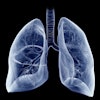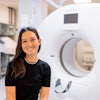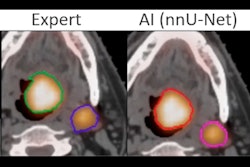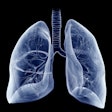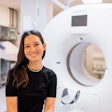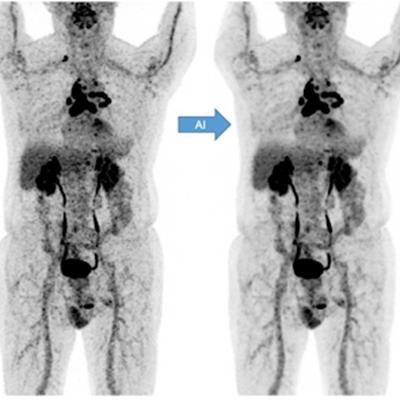
An artificial intelligence (AI) algorithm can improve image quality in half-count F-18 FDG-PET scans, a finding that paves the way for significant cuts in acquisition time in routine clinical practice, nuclear medicine specialists from France have reported.
Nuclear medicine physicians at the Baclesse Cancer Center in Caen compared image quality between PET images acquired in 45 seconds versus 90 seconds using a digital PET/CT scanner. Half-count scans were reconstructed with a commercially available AI denoising algorithm (SubtlePET, Subtle Medical). Visually, global image quality scores between the two were similar, the researchers found.
"Our study thus supports the routine use of SubtlePET combined with a two-fold faster PET acquisition," wrote lead author Dr. Kathleen Weyts. The research was published on 20 May in the European Journal of Nuclear Medicine and Molecular Imaging.
"The benefit of decreasing PET duration, thus reducing waiting time for appointments and helping patients who experience discomfort, outweighs the minor decrease in performance," she added.
SubtlePET was developed by Subtle Medical, a spin-off of Stanford Medical Center in California. The algorithm has been cleared as an AI-based PET image reconstruction tool in the U.S., Europe, and Canada, and it has shown promise in research studies. So far, however, the software has only been installed in a few hospitals.
In this prospective study, the French group aimed to evaluate the algorithm in a clinical setting in images acquired in half the time of standard scans.
The researchers recruited 195 patients referred for imaging at the Baclesse Cancer Center between January and February 2021. Patients underwent whole-body PET/CT scans (Vereos Digital PET/CT, Philips) one hour after F-18 FDG injections.
Next, the researchers performed two PET reconstructions: one for routine clinical purposes using the full acquisition time of 90 seconds per bed position ("PET90"), and a second one using 45 seconds per bed position ("PET45AI"), with reconstruction performed by the algorithm.
Five experienced nuclear medicine physicians reviewed the PET90 and PET45AI images side-by-side, and attributed a global, whole-image quality score to each PET series (1 = poor; 2 = moderate; 3 = good), as well as evaluated cancer lesion detectability.
According to the results, image quality scores were similar between original PET90 and PET45AI, with both receiving good scores in 92% of exams and moderate scores in 8% of exams.
 A 77-year-old man (78 kg; BMI 24 kg/m2) with multifocal lymphadenopathy of unknown origin. MIP views (a) and axial PET slices (b) of F-18 FDG PET90, PET45, and PET45AI. Detection of small left suprahilar lymphadenopathy in all PET series (vertical arrows in b) with respective standard standardized uptake value corrected for lean body mass (SULmax) of 1.8 (PET90), 2.3 (PET45), and 1.7 g/ml (PET45AI). Nonetheless, PET45 images are noisier than PET90 or PET45AI images, particularly in the liver. Image courtesy of the European Journal of Nuclear Medicine and Molecular Imaging.
A 77-year-old man (78 kg; BMI 24 kg/m2) with multifocal lymphadenopathy of unknown origin. MIP views (a) and axial PET slices (b) of F-18 FDG PET90, PET45, and PET45AI. Detection of small left suprahilar lymphadenopathy in all PET series (vertical arrows in b) with respective standard standardized uptake value corrected for lean body mass (SULmax) of 1.8 (PET90), 2.3 (PET45), and 1.7 g/ml (PET45AI). Nonetheless, PET45 images are noisier than PET90 or PET45AI images, particularly in the liver. Image courtesy of the European Journal of Nuclear Medicine and Molecular Imaging.Concerning lesion detection, 33 out of 195 patients presented a normal and concordant examination on both PET series. In the remaining 162 patients, a total of 856 lesions were detected. Of these 856 lesions, the reviewers visualized 836 lesions in both original PET90 and denoised PET45AI scans, which resulted in a lesion concordance rate of 97.7%.
"AI allows F-18 FDG-PET duration in digital PET/CT to be halved, while restoring degraded half-duration PET image quality," the researchers wrote.
The authors noted that one of the strengths of the study was that a large number of the cancer lesions were very different in size, F-18 FDG uptake, nature, and location, while limits included the side-by-side reading methodology, which could have enhanced the detection accuracy in the PET45AI images.
Importantly, however, the prospective study demonstrates that F-18 FDG-PET image quality can be preserved when applying AI-based denoising on half-duration PET, compared with original full-duration PET.
"[The study] paves the way for a significant reduction in acquisition time and the optimization of PET imaging equipment in routine clinical practice," Weyts and colleagues concluded.
